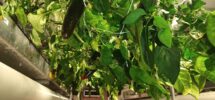
Q: Based on your experience, any advice for others considering their own projects?
Carey: Make sure that you know what the aim of your project is before you get started. Once you get into it, you can be pulled in a thousand different directions. So know what your goal is in mind.
If it is to be profitable, to be servicing grocery stores and restaurants, make sure that you’re crunching your numbers appropriately and that you’ve got those channels in place before.
If it’s community engagement, gauge how willing your community is to jump into these projects, and how you can leverage that enthusiasm to further the project.
We’ve been incredibly fortunate with the support that we have from the Region of Durham, from the town of Ajax, from Durham College and, most importantly, the Barrett Foundation. Taking all that enthusiasm and having a very singular goal in mind of what we were going to execute with this was key to our success.
And don’t be afraid to ask for help. The folks at the Growcer are incredibly well prepared if you have a problem. Chances are they’ve dealt with it before or thought through a solution before you can. So reach out and ask the question, don’t try to reinvent the wheel. Their support staff is incredible.
Makenzie: Make sure you get all your ducks in a row before you get going. There’s unexpected costs that show up. I’m sure the Growcer team remembers us getting started. It was a little bit of a mess. We had to build on a swamp. So Growcer, through an engineering team, helped us design the way that we were going to hold up our units. Then we moved on to water, which was the next issue. We originally thought we were going to use just the city water. We got that tested and it had pythium and fusarium in it. That’s a plant pathogen. It’s fine for humans to have, but plants, that’s a big no go. So we drilled a well and have two particulate filters, a UV filter, as well as a reverse osmosis system, which was originally out of scope. So what I’m trying to get to here is, when you’re budgeting for your site prep, always budget that little bit extra, because you’re always going to run into unexpected things.
Another thing with the production, don’t jump ahead right away. Like I said before you get really excited. I started my full farm up right away. You want your farm full of stuff, but you need a place for that produce to go. I recommend doing either the left side or the right side first, and then one runway per week works perfectly. That way you have produce to bring out for samples and you can give it away to your community. [With a staggered approach] you don’t have an abundance of product that’s going to go to waste. You grow on demand. We didn’t do that at the start, and that’s something that we should have done.


